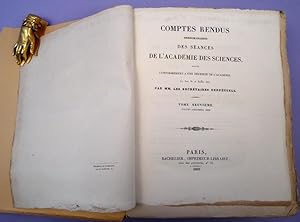arago jacques françois (2 Ergebnisse)
Produktart
- Alle Produktarten
- Bücher (2)
- Magazine & Zeitschriften
- Comics
- Noten
- Kunst, Grafik & Poster
- Fotografien
- Karten
-
Manuskripte &
Papierantiquitäten
Zustand
- Alle
- Neu
- Antiquarisch/Gebraucht
Einband
Weitere Eigenschaften
- Erstausgabe (1)
- Signiert
- Schutzumschlag
- Angebotsfoto (1)
Land des Verkäufers
Verkäuferbewertung
-
Couverture rigide. Zustand: bon. RO80014826: 1868. In-4. Relié demi-cuir. Bon état, Couv. convenable, Dos à nerfs, Quelques rousseurs. 412 pages. Quelques planches de protraits gravés en noir et blanc hors-texte. Nombreuses illustrations en noir et blanc dans le texte. Texte sur 2 colonnes.Titre et fleurons dorés sur le dos cuir marron. Quelques légères épidermures sur le cuir. . . . Classification Dewey : 910.4-Voyages.
-
Le Daguerreotype
Verlag: Bachelier, Paris, 1839
Anbieter: Jeremy Norman's historyofscience, Novato, CA, USA
Erstausgabe
1st edition. [Daguerre, Louis-Jacques-Mandé (1787-1851).] Arago, François (1786-1853). Le Daguerréotype. In: Comptes rendus IX (July-Dec. 1839): 250-67. 4to. [4], 903, [1]pp. Paris: Bachelier, 1839. Later wrappers, uncut & unopened. Slight browning & foxing but fine. First Edition of the first official disclosure of the "daguerreotype" photographic process invented in the 1830s by Louis Daguerre (1787-1851), preceding the publication of Daguerre's Historique de description des procédés du daguerreotype et du diorama (1839). The daguerreotype was the first practical and commercially viable photographic process, and the first to be announced publicly. Daguerre, an artist and chemist, had been working for over a decade on methods of fixing images photographically, initially in partnership with Joseph Nicéphore Niépce (1765-1833), whose "heliographic" process, developed in the 1820s, is now recognized as the first successful example of photography. After Niépce's death Daguerre continued investigating photographic methods on his own, eventually coming up with the famous "daguerreotype" process, in which an image is exposed directly onto a mirror-polished surface of silver coated with silver halide particles. After trying unsuccessfully to market his process to private shareholders Daguerre looked to the French government for funding, enlisting the support of the distinguished astronomer and physicist François Arago, permanent secretary of the Académie des Sciences and a member of the Chamber of Deputies. Arago briefly announced Daguerre's discovery to the Académie on January 7, 1839, then persuaded the government to purchase Daguerre's patent in exchange for lifetime annuities granted to Daguerre and the estate of Niépce. On July 3, 1839 Arago submitted a report on the daguerreotype to the Chamber of Deputies, and on August 19 Daguerre's process was "given to the world" in the present paper read by Arago at the Académie des Sciences. This volume of the Comptes rendus contains 24 other papers on photography, mostly commenting on Daguerre's invention. Among the contributors were Hippolyte Bayard (1801-87), promoter of a rival photographic method based on that of Fox Talbot; Alfred Donné (1801-78), who would later publish the Cours de micrographie (1844); and Noel Marie Lerebours (1807-73), seller of photographic equipment and distributor of Daguerre's photographic manual. Horblit, One Hundred Books Famous in Science, 21b. See Printing and the Mind of Man 318. .



